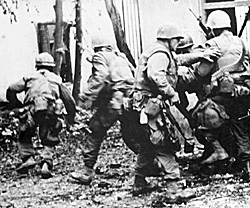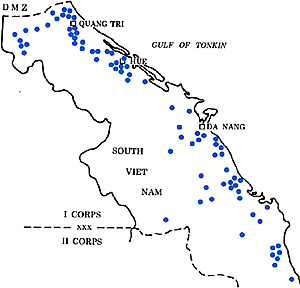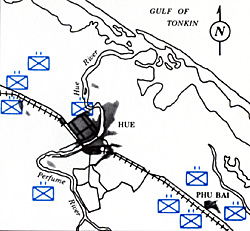 The idea of the Tet Offensive of February 1968 was basically decided in July 1967, and as it now seems, the concept of hitting all the important cities was primarily Gen. Giap's. It was not a reckless, last ditch gamble, but then again, it wasn't a stroke of military genius. It was a cooly analyzed calculated risk, which offered a reasonable chance to gain more politically than it would lose militarily. And like any large offensive, it would require a great deal of planning and preparation, and like any great offensive, it would require a good dash of luck.
The idea of the Tet Offensive of February 1968 was basically decided in July 1967, and as it now seems, the concept of hitting all the important cities was primarily Gen. Giap's. It was not a reckless, last ditch gamble, but then again, it wasn't a stroke of military genius. It was a cooly analyzed calculated risk, which offered a reasonable chance to gain more politically than it would lose militarily. And like any large offensive, it would require a great deal of planning and preparation, and like any great offensive, it would require a good dash of luck.
The basic theory was that the Americans would be much more interested in the constant frontier battles like Dak To, Loc Ninh, and Khe Sanh to be very concerned with the mundane task of city security. And consequently, the cities would be vulnerable.
Secondly, if a major city would be captured, the National Liberation Front (NLF) would be able to openly proclaim a provisional government complete with a South Vietnamese capitol. The political advantage of this would be easily worth the loss of two divisions it would probably require. Also, if this could be repeated with enough cities, then perhaps a "General Uprising" would occur and the Saigon government would crumble.
Now Giap was a military man, who knew the firepower potential of the Americans and realistically figured that the taking of a major city had probably one chance out of six. However, if a total of at least 24 major cities were attacked, that would mean that the North Vietnamese Army and Viet Cong would probably end up with four, which would have been worth the effort.
Of course, some cities were more valuable than others. Saigon was first, for obvious reasons. But, Hue was probably second, and for not so obvious reasons.
Hue
Hue's desirability was based on two basic points, one military, one political. The military issue was plain. Should the NVA or VC successfully capture Hue, its closeness to the well infiltrated DMZ would make it relatively easy to reinforce with fresh regular troops from the north. Conceivably, if Giap were willing to spend the troops, Hue could be held indefinitely. Also, its moats and walls would guarantee that any attacker attempting to recapture the city would suffer heavy casualties. However, even more relevant than this was the immense political value of Hue.
Since 1687 it has been the imperial capital of Vietnam and historically, Hue had become the symbolic city of Vietnamese resistance to foreigners. It symbolized independence. Hence, it was the ideal city from which to proclaim the new provisional government. Also, due to its historical significance, if the Americans used their terrific "indirect" weaponry it would turn all Vietnamese, both North and South, against them. Imagine the Vietnamese reaction if we had used B-52's on Hue. It would've been like their bombing Mount Vernon.
However, while it was obvious why Hue should be seized, the actual taking of it presented a considerable military problem. First, it was the headquarters of the ARVN 1st Division, the best divisional unit in the South Vietnamese army, competent and having high morale. They could be counted on to fight well. And then there was the question of the U.S. Marines. Giap was well aware that in every large unit battle with them his people had come out distinctly second best. The conclusion was inescapable. The NVA might be able to hold Hue, once it got it, but the only way it could really hope to take it would be if both the ARVN First Division and the U.S. Marines would leave it wide open. As events would show, this was not that far fetched a hope.
At this point, it is best to note the relative balance of military power in I Corps. Every war has a basic military unit, which is the prime maneuvering element of that war. In World War II it was the division, in Vietnam it was the battalion. And the number of available combat battalions an Army has in Vietnam is probably the best indicator of its "cutting edge."
At the time of the Tet offensive the opposing strengths, in I Corps, looked like this:
| U.S.= 38 ARVN= 35 ROK (Korean)= 4 | NVA = 46 VC = 19 |
| 65 battalions | 77 battalions |
 However, these figures do not take into account that the U.S. battalions are larger and have more organic firepower than do those of the other participants. U.S. battalions had about a 50% firepower edge over the others. Taking this into consideration the Allied battalions had the equivalent firepower of 96 battalions.
However, these figures do not take into account that the U.S. battalions are larger and have more organic firepower than do those of the other participants. U.S. battalions had about a 50% firepower edge over the others. Taking this into consideration the Allied battalions had the equivalent firepower of 96 battalions.
The map of I Corps area shows the theoretical dispositions of the Allied battalions prior to the Tet offensive. The inset (below) shows the actual location of the Allied battalions in the vicinity of Hue just before the NVA attack. Note how the western approaches were left relatively wide open, particularly towards the south. As can be seen by comparing the two maps, the neglect of these areas was not intentional, it just happened.
 Finally a further correction should be made for the tremendous air power available to the Allied ground troops. Depending on the season, this could give the Allies anywhere from a 30% to a 60% combat edge. Since Hue was fought in the middle of the monsoon season the 30% figure would be the more accurate of the two. Adding that factor gives the Allies, in I Corps, a battalion firepower equivalent of 125 NVA/VC battalions.
Finally a further correction should be made for the tremendous air power available to the Allied ground troops. Depending on the season, this could give the Allies anywhere from a 30% to a 60% combat edge. Since Hue was fought in the middle of the monsoon season the 30% figure would be the more accurate of the two. Adding that factor gives the Allies, in I Corps, a battalion firepower equivalent of 125 NVA/VC battalions.
Hence in "battalion factors" the Allied forces would have 125 vs. 65, just about "2-to-1," and that is certainly not a decisive edge, particularly if the enemy has "hidden movement" for most of his units.
Another point these figures do not take into account is the ARVN Regional Forces (21,000) and the ARVN Popular Forces (23,000) mainly because of their erratic military capability and the fact that they were fairly much balanced out by the 20,000 or so Viet Cong guerrillas in non-battalion formations in I Corps.
More Tet Offensive
-
Tet Offensive: Introduction
Tet Offensive: US and North Vietamese Strategy
Tet Offensive: Battle for Hue
Tet Offensive: Soldiers
Tet Offensive: Tactical Organization and Equipment
Tet Offensive: Maps: Battle for Hue (very slow: 329K)
Back to Conflict Number 6 Table of Contents
Back to Conflict List of Issues
Back to MagWeb Master Magazine List
© Copyright 1973 by Dana Lombardy
This article appears in MagWeb (Magazine Web) on the Internet World Wide Web.
Other military history articles and gaming articles are available at http://www.magweb.com